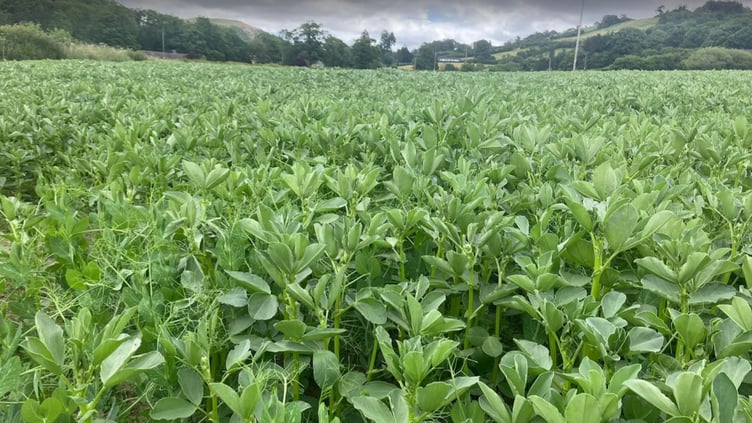A Powys livestock farmer has captured a winter feed cost saving of £2,572 by growing his own protein crop, but results from that trial have shown how important weather conditions are to yield and quality in a bi-crop of peas and beans.
Robert Lyon runs a beef and sheep system at Lower House Farm, a Farming Connect ‘Our Farms’ farm near Llandrindod Wells.
Robert’s ambition is to make his system self-sufficient in protein feed by replacing bought-in blend with home-grown beans and peas.
As a first step, he embarked on a trial as part of his Our Farms project work, but that study was in a year when establishment and growing conditions were challenged.
The combination of a two-month delay in getting the seed into the ground and the crop failing to fully ripen during an exceptionally wet and overcast summer saw the crop yield less than a third of the projected tonnage, and compromising its energy potential.
The 4.9-hectare (ha) crop had been expected to produce 30 tonnes of feed – the equivalent of 6t/ha – but the entire field in fact yielded just 9t.
This had an impact on cost, says Farming Connect Sector Officer Simon Pitt, who oversaw the project.
Cost of production was £439.68/tonne (t) – if it had produced the yield expected that cost would have been only £129.19/t.
A feed value analysis of the crimped pulses showed a protein level in the dry matter of 26.6% but inadequate ripening resulted in a lower ME than expected, at 12.8MJ/kg.
Simon admits that although the results were disappointing, as a direct consequence of the weather, previous similar trials in years when conditions were more favourable had demonstrated a very positive return on investment.
For example, a similar study at Pantyderi Farm, Boncath, in 2024 saw the crop yield of 5.25t/ha - 42 tonnes from 8ha – and an ME of 13.6MJ/kg.
A lesson learned from the study at Lower House Farm showed how important favourable weather is to establishing and growing crops, including protein, said Simon.
The target had been to get the seed sown in April but very wet conditions resulted in a two-month delay.
It was direct drilled in two separate passes in early June - the spring bean variety, Genius, sown at a rate of 308kg/ha at a depth of 70mm followed by the Carrington Spring pea variety at 206kg/ha at 40mm depth.
No pesticides or herbicides were applied from sowing to harvesting in mid-September.
A summer when sunshine and warmth were lacking resulted in the crop failing to fully ripen, creating challenges during harvesting as the material repeatedly blocked the combine.
A preservative was applied to control fermentation in the clamp and prevent aerobic losses during feed out.
A ration was formulated for 45 British Blue-cross heifers weighing an average of 350kg to produce a gain of 1kg/day over a five-week period, although actual growth achieved was 0.545kg/head/day.
The results in Robert’s sheep flock were more favourable.
In 2024 he purchased crimped peas and beans grown at Pantyderi to feed to pregnant ewes. These were incorporated in a total mixed ration (TMR) with grass and maize silage.
The lambs born to the ewes that were fed that ration outperformed those that were given a 50% crude protein concentrate in their mix, gaining an extra average daily liveweight gain (DLWG) of 40g/lamb, around 2.8 kg over 10 weeks. Lambs were also sold earlier which meant fields were freed up to be grazed by ewes.
At a price of 654.50p/kg deadweight, that gain was worth £8.61/lamb.
Robert says he would incorporate crimped peas and beans in the ewe diet in future years but it wouldn’t be homegrown as the project had shown him that the crop is not suited to the climate that he farms in.
“If I farmed in a county that had less rain, Pembrokeshire or Herefordshire, without doubt it is something I would consider growing because it is nitrogen fixing and it is a good way to turn over an old sward, and it makes a nice ration but you have got to have the right climate to make it work,” he said.
“If I could persuade another farmer to grow it for me it is definitely a good fit for the TMR.’’
The outcome would have been more favourable, he believes, had he taken the crop earlier and whole-cropped it instead, instead of taking it through to the combining stage.





Comments
This article has no comments yet. Be the first to leave a comment.